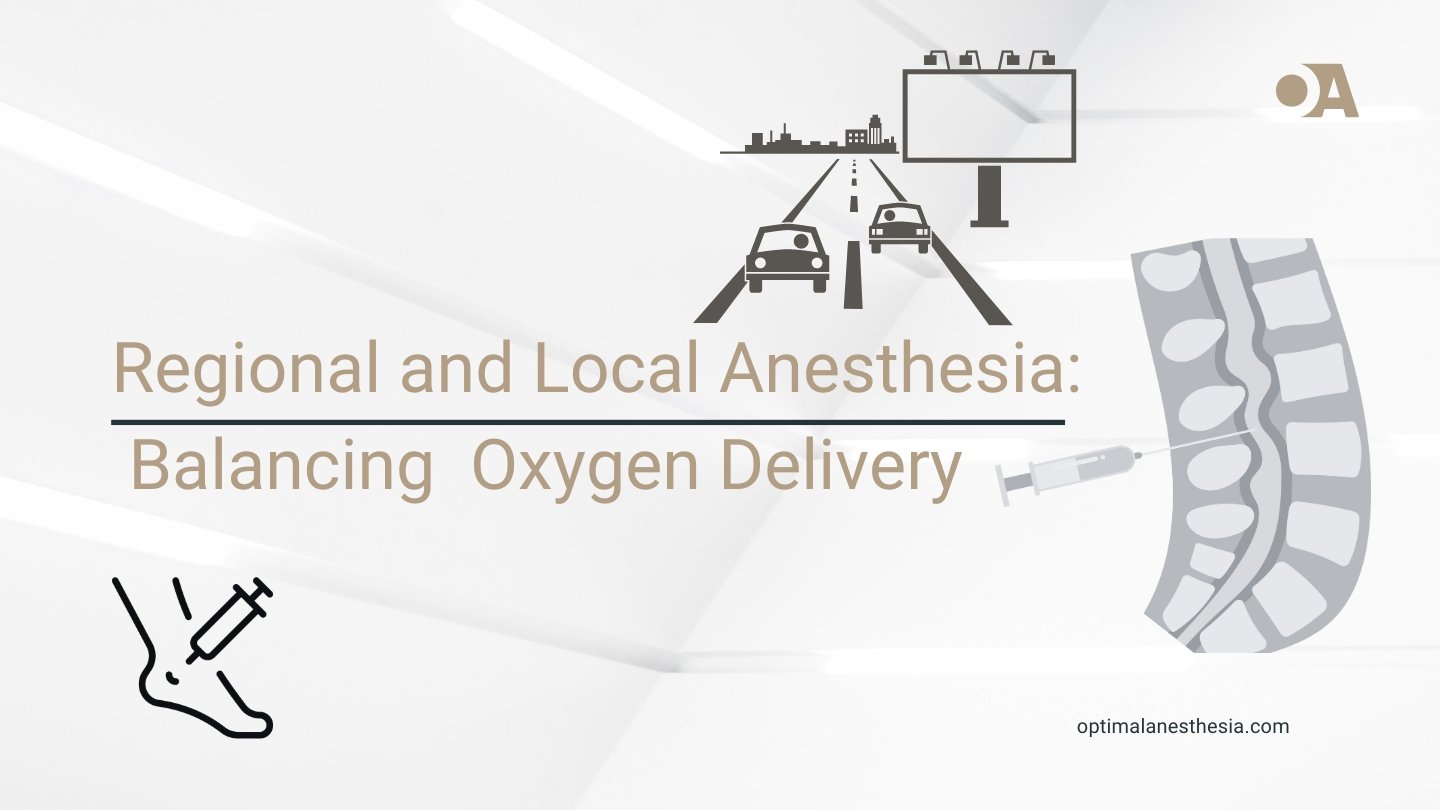Regional and local anesthesia are essential techniques in modern anesthesiology, offering benefits such as reduced systemic effects and improved postoperative pain control. However, these techniques are not without challenges, particularly regarding their impact on oxygen delivery (oxygen flux) and hemodynamic stability. An understanding of how regional and local anesthesia can influence oxygen flux is critical for ensuring optimal patient outcomes, especially in high-risk populations. This article explores the mechanisms through which regional and local anesthesia affect oxygen delivery and highlights key clinical implications for anesthesiologists.
1. Regional Anesthesia: Sympathetic Blockade and Oxygen Delivery
1.1. Mechanisms of Regional Anesthesia
Regional anesthesia techniques, such as thoracic epidural anesthesia (TEA) and spinal anesthesia, involve the administration of local anesthetics near the spinal cord to block nerve transmission. These techniques produce sensory, motor, and autonomic blockades, with the blockade of sympathetic nerves having significant hemodynamic effects.
1.2. Sympathetic Blockade and Hemodynamics
By blocking sympathetic outflow, regional anesthesia induces vasodilation in the areas innervated by the blocked nerves. This vasodilation leads to a reduction in systemic vascular resistance and hypotension. The extent of these hemodynamic effects depends on the level and intensity of the block. For instance, a high thoracic epidural block can impact sympathetic nerves innervating the heart, reducing cardiac output and potentially leading to bradycardia. Additionally, regional anesthesia can cause a redistribution of blood flow due to vasodilation in blocked areas, resulting in decreased preload and cardiac output. This effect is particularly pronounced in elderly patients or those with cardiovascular disease, where compensatory mechanisms are often blunted.
1.3. Oxygen Flux Considerations in Regional Anesthesia
Although regional anesthesia typically has more localized effects than general anesthesia, the reduction in cardiac output and vasodilation can impair overall oxygen delivery. For example, a thoracic epidural block can reduce venous return and stroke volume, leading to decreased cardiac output. In patients with limited cardiovascular reserve, this reduction in oxygen flux can result in inadequate tissue perfusion and oxygenation.
During periods of increased metabolic demand, such as surgical stress, the sympathetic blockade-induced decrease in cardiac output may lead to an oxygen supply-demand mismatch. This mismatch can cause ischemia in tissues with high oxygen consumption, such as the myocardium and skeletal muscles.
1.4. Clinical Implications for Regional Anesthesia
To mitigate the effects of sympathetic blockade on oxygen delivery, careful titration of regional anesthesia is essential. Monitoring for signs of hypotension and bradycardia is crucial, and appropriate interventions, such as fluid administration or the use of vasopressors (e.g., epinephrine, norepinephrine), may be necessary. In patients with pre-existing cardiovascular conditions, lower doses of local anesthetics or combined regional-general anesthesia techniques can be considered to minimize hemodynamic instability.
2. Local Anesthesia: Systemic Absorption and Cardiac Effects
2.1. Mechanisms of Local Anesthesia
Local anesthesia involves the injection of anesthetic agents, such as lidocaine or bupivacaine, near specific nerves to block sensory and motor function in a localized area. While local anesthesia generally has minimal direct effects on cardiac output compared to general and regional anesthesia, systemic absorption of local anesthetics can have significant cardiovascular implications.
2.2. Cardiac Sodium Channel Blockade and Hemodynamics
Local anesthetics exert their effects by blocking voltage-gated sodium channels in nerve cells, preventing action potential propagation. However, if local anesthetics are absorbed into the systemic circulation, they can also block sodium channels in cardiac myocytes, leading to conduction disturbances, arrhythmias, or even cardiac arrest. Bupivacaine, in particular, is associated with higher cardiotoxicity due to its strong affinity for sodium channels. Large doses or unintentional intravascular injection of local anesthetics can result in hypotension and decreased cardiac output by impairing myocardial contractility and conduction.
2.3. Oxygen Delivery and Hemodynamic Stability in Local Anesthesia
Although local anesthesia typically affects oxygen delivery to a lesser extent than general or regional anesthesia, systemic absorption of local anesthetics can still pose risks to hemodynamic stability. If cardiac output is compromised due to arrhythmias or reduced contractility, oxygen delivery to tissues may be impaired, potentially leading to tissue hypoxia and ischemia.
2.4. Clinical Implications for Local Anesthesia
To minimize the systemic effects of local anesthetics, careful dosing and injection techniques are essential. The use of epinephrine as an additive to local anesthetics can help reduce systemic absorption by causing vasoconstriction, thereby limiting the spread of the anesthetic into the bloodstream. Monitoring for signs of toxicity, such as central nervous system symptoms (e.g., tinnitus, seizures) or cardiovascular symptoms (e.g., arrhythmias), is also critical during procedures involving local anesthesia.
Conclusion
Regional and local anesthesia techniques offer significant benefits in perioperative care, but their impact on oxygen flux must be carefully managed to prevent adverse outcomes. Anesthesiologists should remain vigilant in monitoring hemodynamic parameters and oxygen delivery, particularly in patients with compromised cardiovascular function. By understanding the mechanisms of sympathetic blockade, systemic absorption, and their effects on oxygen flux, anesthesiologists can tailor their approach to ensure patient safety and optimize perioperative care.


